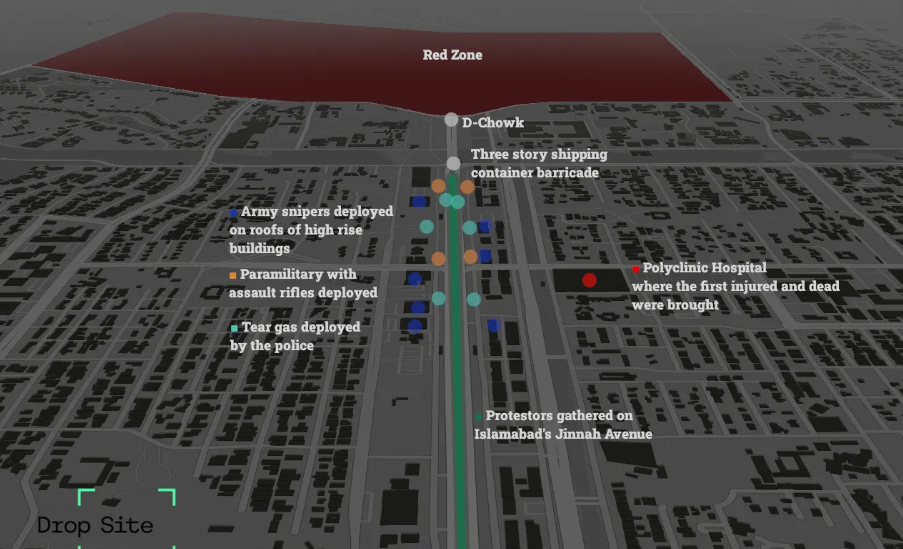Murtaza Hussain and Ryan Grim’s investigative story, Leaked Information Reveals Pakistan Army Planned Its Brutal Crackdown on Protests, Including Live Fire and Subsequent Cover-up, sheds light on the Pakistan Army’s planned crackdown on PTI supporters. Their detailed account reveals the lengths to which the military went to suppress dissent and control the narrative. This story underscores the importance of investigative journalism in uncovering the truth and holding those in power accountable.
Leaked Brutal Crackdown Details
In a chilling revelation, sources inside the Pakistan Army have disclosed a planned lethal crackdown on supporters of the imprisoned former Prime Minister Imran Khan. The plan, confirmed by a second source, included a communications blackout, snipers, tear-gas armed soldiers, strategic blockades in Islamabad, and the use of live ammunition. These “leaked brutal crackdown details” underscore the alarm within Pakistan’s military government regarding Khan’s Pakistan Tehrik e Insaf (PTI) party supporters. Despite repeated government denials, the details suggest confidence in their ability to crush dissent and dismantle the pro-PTI movement.
The Call for Demonstrations
On November 26, Khan called for demonstrations in Islamabad. Thousands of PTI supporters responded, overcoming obstacles and internet shutdowns to reach the capital. Led by Khan’s wife, Bushra Bibi, and Ali Amin Gandapur, the chief minister of Khyber Pakhtunkhwa, the protesters faced significant resistance. The government shut down social media apps and called in the military, granting them shoot-on-sight powers. Despite these measures, by the evening of November 26, protesters had reached the heart of Islamabad, near the central D-Chowk roundabout.
The Military’s Plan
According to the source, the operation was planned on November 25 at the Military Operations directorate under General Asim Munir, Pakistan’s chief of army staff. The plan involved encircling Jinnah Avenue with shipping containers, deploying snipers from the Pakistan Army Special Services Group (SSG) on rooftops, and patrolling the area with paramilitary rangers and police armed with tear gas.
Execution of the Crackdown
As night fell, thousands of PTI supporters gathered on Jinnah Avenue. Meanwhile, the military’s orders were clear: prevent the protesters from reaching D-Chowk at all costs. Initially, the first phase involved creating chaos and fear by extinguishing lights and jamming communications. Consequently, this blackout disoriented and demoralized the protesters. Furthermore, the second phase saw the use of tear gas from multiple directions, which caused panic and confusion.
The Main Assault
The main assault involved a barrage of live ammunition directed at the fleeing crowds. Furthermore, snipers targeted those deemed hostile or threatening. In addition, Aleema Khan, Imran Khan’s sister, described the scene as chaotic, with protesters plunged into darkness and cars turning off their lights to avoid becoming targets. Meanwhile, the younger protesters tried to throw back tear gas canisters, while the elderly sought cover. Moreover, “Leaked brutal crackdown details” reveal that the operation’s technological sophistication was evident with the use of a MALE UAV and smaller drones with thermal imaging capability, providing live surveillance. Consequently, this indicated the premeditated nature of the crackdown.
Technological Sophistication
The final phase involved a swift cleanup by ISI units, removing bodies, shell casings, and any evidence contradicting the government’s narrative of a peaceful dispersal. “Leaked brutal crackdown details” show that eyewitness accounts from protesters and medical professionals corroborate the source’s information. Reports detail snipers shooting into crowds and the use of live ammunition. Efforts to conceal evidence included confiscating medical records and pressuring medical staff to remain silent. The deployment of Pakistan Army SSG snipers on rooftops aligns with eyewitness testimonies and video evidence.
Suppression of Information
Journalist Matiullah Jan, a critic of the military’s influence, was abducted, arrested, and charged with terrorism and possession of narcotics after investigating the protest casualties. Amnesty International condemned his arrest, calling the charges “trumped-up” and “politically motivated.” The PTI reported at least 14 deaths and around 200 injuries, with hundreds of protesters missing.
Conclusion
Murtaza Hussain and Ryan Grim’s investigative story, furthermore, sheds light on the Pakistan Army’s planned crackdown on PTI supporters. Moreover, their detailed account reveals the lengths to which the military went to suppress dissent and control the narrative. Consequently, this story underscores the importance of investigative journalism in uncovering the truth and holding those in power accountable.



